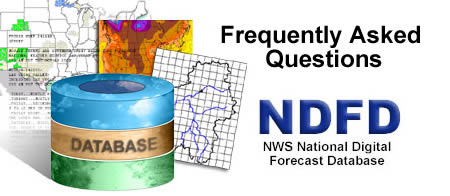
Frequently Asked Questions About NDFD
Q. In what formats can I access NDFD grids?
A. NDFD grids are encoded in WMO standard GRIB v2 format. A downloadable
GRIB2 decoder is available that can output NDFD grids as shapefiles, netCDF,
GrADS, float files, and comma separated variable files.
Q. W hat can I do if none of the 16 predefined NDFD sectors
matches the area for which I need forecasts?
A. An experimental
web service that provides the capability to download NDFD grids for user-defined
domains is now online.
Q. Is forecast data from the NDFD available
as an XML data feed?
A. Forecast data from the NDFD is available in XML format.
Further information can be found at: http://www.nws.noaa.gov/xml/
Q. When will NDFD forecast elements become operational?
A. The status of NDFD elements can be found at: http://www.nws.noaa.gov/ndfd/resources/NDFD_element_status.pdf
Q. How frequently are the updates to the NDFD gridded data
made available?
A. The gridded forecast products in the NDFD are updated once per hour.
Q. Where can I find NDFD verification scores?
A. An initial set of quality assessment information for the NDFD gridded forecasts
is available at: http://www.nws.noaa.gov/ndfd/verification/index.htm
Q. Where in NDFD do I find information
on past weather?
A. The NDFD currently contains only forecast data. A good place to look for historical
observational data is the National Climatic Data Center at: http://www.noaa.gov/pastweather.html or http://www.ncdc.noaa.gov/oa/ncdc.html
Q. At what times are NDFD forecasts updated? What can
I do if they are missing?
A. Our target is to provide an updated set of forecast grids by the top of
each hour. During periods of high-volume, updates are sometimes delayed until 5-10
minutes after the hour. Please contact the staff at the NWS Telecommunications
Operations Center (TOC) for questions or problems regarding data access, and availability.
The phone number of the TOC is 301-713-0902. The TOC is staffed 24 hours per day,
7 days a week including holidays, to provide customer support for the NDFD data
disseminated via the ftp and http protocols.
Q. How do I access past NDFD forecast?
A. Historical
NDFD forecasts are archived at the National Climatic Data Center
. Instructions on how to access past NDFD forecasts can be
found at: http://www.weather.gov/mdl/NDFD_GRIB2Decoder/pastwx.php
Q. Why are there sometimes holes in the NDFD mosaics?
A. NWS forecast offices attempt to provide forecasts to the NDFD in a timely
fashion. On an average day, 5-10% of all offices in the CONUS fail to provide grids
for all required elements and times.
Q. Why do I sometimes see unnatural discontinuities in
the NDFD grids?
A. Each forecast office prepares gridded forecasts for a specific area of
responsibility. When these locally generated forecasts are merged into a national
mosaic, occasionally lines of discontinuity will be evident. Staff at NWS forecast
offices attempt to resolve discontinuities along the boundaries of the forecasts
using forecast tools that identify and resolve these differences. We are making
progress in this area, and recognize that this is an area in which we still need
to improve.
Q. W here can I find information on the weather text strings
in NDFD grids ?
A. The abbreviations for weather types in NDFD can be
found in Section 2 of the GRIB encoding details at http://www.weather.gov/forecasts/graphical/docs/grib_design.html
Q. Why do weather types appear in the grids that are not defined
in the GRIB documentation?
A. Local Weather Forecast Offices sometimes employ special weather types for their
own local purposes.
Q. How can I access a forecast for a specific date and location?
A. NDFD graphical
forecasts are posted on the web. You can access the latest NWS text forecasts
for any point along a route by clicking down to the local forecast office web pages
from these graphics of the national scale forecasts.
Q. Why are the graphical forecasts on the national, regional,
and state graphics on http://www.weather.gov/forecasts/graphical/sectors/index.php sometimes
inconsistent with those available on the local forecast office
web pages?
A. In general, graphics produced by local forecast offices are not updated as frequently
as the NDFD forecast graphics. The forecast currency link near the bottom of the
NDFD graphics pages indicates how long it has been since any particular WFO has
provided an update to NDFD
Q. How can I convert the NDFD girds
from GRIB2 format to GIS files?
A. The DEGRIB [link to http://www.nws.noaa.gov/mdl/NDFD_GRIB2Decoder/ ]
tool developed by the Meteorological Development Laboratory provides a driver with
the capability to convert the GRIB2 data to a file format that can be used with
Geographical Information System (GIS) software.
If you have a question that is not answered here, please contact
us.
|